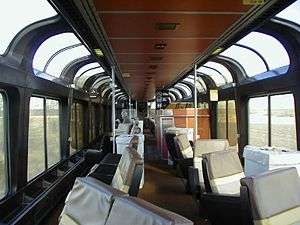Lounge car
A lounge car (sometimes referred to as a buffet lounge, buffet car, or club car) is a type of passenger car on a train, in which riders can purchase food and drinks.[1] The car may feature large windows and comfortable seating to create a relaxing diversion from standard coach or dining options. In earlier times (and especially on the "name" trains), a lounge car was more likely to have a small kitchen, or grill and a limited menu. Food was prepared to order and often cooked, though items such as club sandwiches would have usually been part of the offerings. The cars were often operated by the Pullman Company, and in other cases by the railroad directly as part of the dining car department (on the Atchison, Topeka and Santa Fe Railway the Fred Harvey Company manned the food concession).
Lounge cars operated by Pullman were exclusively for the use of sleeping car passengers, while those operated by the railroad were available to coach as well as first-class travelers. Buffet lounge cars were often found in trains which did not offer full dining car service. On other trains they supplemented the diner and offered sandwiches, burgers and short orders at times when the diner was not serving; e.g. mid-afternoon and late night. To qualify as a buffet lounge the car had to offer both food and drink service. Buffet lounges should not be confused with snack or grill cars which did not offer a full range of libations.[2]
In Britain, luxury lounge cars are known as "Pullman" cars, after the American Pullman Company.
Tavern-lounge cars
Tavern-lounge cars, alternatively called tavern-observation cars, were lounge cars often with partitions, where refreshments were offered for sale. In use from the post-World War II years, into the 1960s, these appeared on long-distance routes, such as the Atlantic Coast Line's Champion, the Kansas City Southern's Southern Belle, Louisville & Nashville's Humming Bird, Georgian, or the New York Central's New York-St. Louis Southwestern Limited. As apparent in the ACL's all-coach Vacationer, this sub-class of car was not only used in Pullman trains.[3] Like standard lounge cars, these had seats and couches facing away from windows and toward the aisles. Many of these were equipped with radios with which to play music via radio or recordings.[4][5][6]
See also
References
- White, John H. (1985) [1978]. The American Railroad Passenger Car. Baltimore, Maryland: Johns Hopkins University Press. ISBN 978-0-8018-2743-3.
- http://www.merriam-webster.com/dictionary/club+car
- http://forums.railfan.net/forums.cgi?board=PassengerTrains&action=display&num=1134687599
- American Rails, Vacationer, https://www.american-rails.com/vacationer.html
- 1961 Atlantic Coast Line Timetable, p. 9
- 1947Louisville & Nashville Timetable http://viewoftheblue.com/photography/timetables/L&N82447.pdf
- 1948 New York Central Timetable, p. 6 http://streamlinermemories.info/NYC/NYC48-4TT.pdf
External links

- Amtrak Lounge Cars

